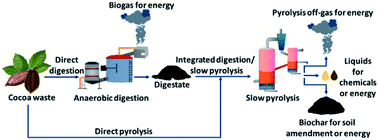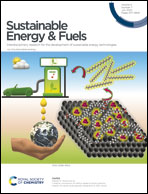Integrating anaerobic digestion and slow pyrolysis improves the product portfolio of a cocoa waste biorefinery†
Abstract
The integration of conversion processes with anaerobic digestion is key to increase value from agricultural waste, like cocoa pod husks, generated in developing countries. The production of one metric ton of cocoa beans generates some 15 metric tonnes of organic waste that is today underutilized. This waste can be converted into added value products by anaerobic digestion, converting part of the cocoa pods to biogas while releasing nutrients, and pyrolysis. Here, we compared different scenarios for anaerobic digestion/slow pyrolysis integration in terms of product portfolio (i.e., biogas, pyrolysis liquids, biochar and pyrolysis gases), energy balance and potential for chemicals production. Slow pyrolysis was performed at 350 °C and 500 °C on raw cocoa pod husks, as well as on digestates obtained from mono-digestion of cocoa pod husks and co-digestion with cow manure. Anaerobic digestion resulted in 20 to 25 wt% of biogas for mono and co-digestion, respectively. Direct pyrolysis of cocoa pod husks mainly resulted in biochar with a maximum yield of 48 wt%. Anaerobic digestion induced compositional changes in the resulting biochar, pyrolysis liquids and evolved gases after pyrolysis. Pyrolysis of mono-digestate e.g., resulted in a more energy-dense organic phase, rich in valuable phenolics while poorer in light oxygenates that hold a modest value. Our comparison shows that co-digestion/slow pyrolysis at 500 °C and mono-digestion/slow pyrolysis at 350 °C both present high-potential biorefinery schemes. They can be self-sustaining in terms of energy, while resulting in high quality biochar for nutrient recycling and/or energy recovery, and/or phenolics-rich pyrolysis liquids for further upgrading into biorefinery intermediates.



 Please wait while we load your content...
Please wait while we load your content...